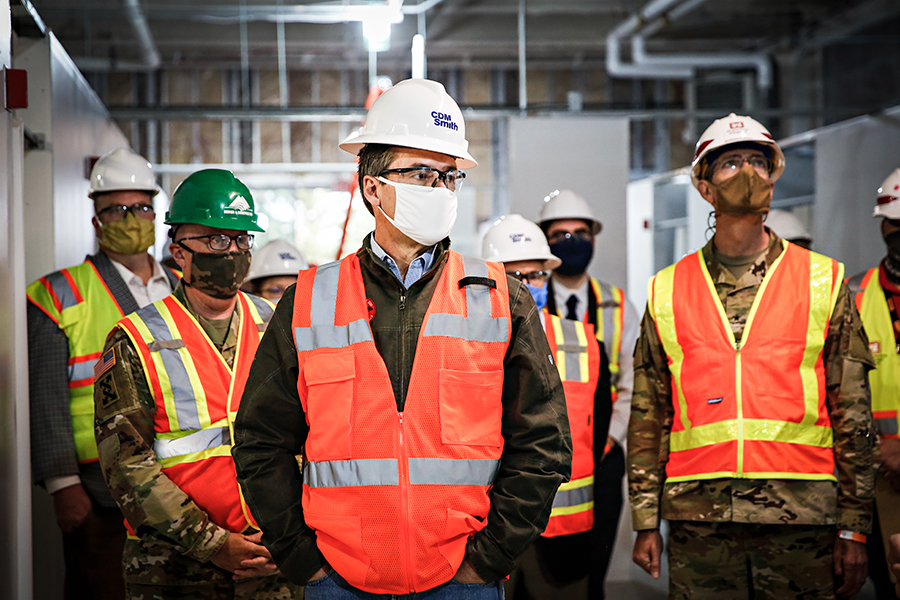Montana Could Receive First Vaccination Shipment by Mid-December
Gov. Steve Bullock announced a tentative timeline for vaccinations and implored Montanans to wear a mask
By Micah Drew
Gov. Steve Bullock on Wednesday announced that Montana could receive the first shipment of vaccinations for COVID-19 as soon as Dec. 15. The state is expected to receive an initial shipment of around 9,750 doses of the vaccination developed by the drug company Pfizer, with several thousand more doses in subsequent weeks. If approved, another drugmaker, Moderna, is expected to begin shipping vaccinations a week later.
“The vaccination plan really is a work in progress, a work in motion, as we move forward,” Bullock said during the press call, emphasizing that new information was coming together every day.
The pending vaccinations will arrive after Montana experienced record numbers of positive cases, hospitalizations and deaths during the month of November. As of Dec. 2, more than 64,000 Montanans have been diagnosed with the novel coronavirus, including 937 new cases reported Wednesday. The state has reported 713 deaths due to the virus.
According to the governor, the federal advisory committee voted Tuesday to recommend to the Centers for Disease Control that the initial vaccinations should be offered to health-care personnel and residents of long-term care facilities.
Montana has between 45,000 and 60,000 health-care workers in the state and long-term and senior care facilities have an estimated 10,000 total staff and residents.
The vaccine allocation will be handled by the Department of Public Health and Human Services (DPHHS) and will work with partners in the state that have the capacity for cold storage, a requirement for the Pfizer vaccine.
Bullock also announced that the last of the $1.25 billion in federal CARES Act dollars Montana received had been allocated, and the money will be exhausted by the deadline at the end of the month.
“A billion and a quarter dollars is a significant sum of money, but the pandemic and its related impacts have drawn on these funds for nearly nine months now,” Bullock said. “Those impacts have been enough to exhaust the entire coronavirus relief funds and yet that’s still not enough to offset every financial loss we’ve seen throughout the state.”
The governor recapped how the $1.25 billion had been allocated throughout the year, noting that the emphasis had been on directing funding to Montana citizens and businesses. The state allocated $254 million in three rounds of stabilization grants to support local businesses.
“However, the pandemic continues on, and with it the financial and health impacts in all corners of our state,” Bullock said. “It will continue long beyond the federal government’s end date for the CARES Act.”
Bullock said the federal government needed further action to help its citizens, saying the pandemic is a “storm that cannot be weathered without federal support.”
Bullock also mentioned that coronavirus relief dollars were used to hire 229 medical staffers from around the country that are currently deployed as frontline workers serving in Montana hospitals. He noted that many hospitals remain near maximum capacity and said Kalispell Regional Medical Center is readying an alternative care facility to provide at least 50 beds for non-COVID patients.
“I would just encourage people to recognize that the actions that we take even without a vaccine are what will limit the further spread and transmission of this virus … will make it much more likely that we will make it through December without having another record month of deaths,” Bullock said. “Wear the damn mask! Stay home.”
The Pfizer vaccine is reported to be 90% effective and was granted emergency authorization by the United Kingdom on Wednesday morning. The United States has yet to grant a similar authorization to the company, which filed an emergency application with the Food and Drug Administration in November.
Moderna has similarly applied for emergency use authorization from the FDA, and is about one week behind Pfizer in the process. The company’s data shows the vaccine is 94.5% effective. Both vaccinations require two shots for the doses to be fully effective.